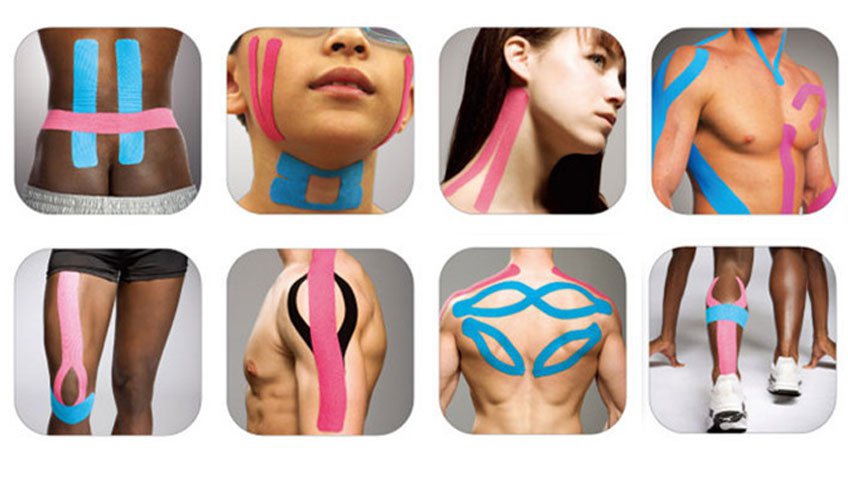Kinesio tape therapy
Kinesiological taping was developed by a Japanese doctor almost 30 years ago and the method has been playing an increasing role ever since, both in the field of prevention and rehabilitation. Its effect is based on the fact that the sensitive receptors in the skin conduct impulses to the spinal cord more quickly than pain sensitive receptors. The pieces of information coming from these touch-sensitive receptors prevent the pain stimuli from entering and thus being processed in the brain. The advantage of the tape treatment is that its effect lasts for 24 hours. The tape can be worn continuously for 3 to 5 days as if the therapist’s hand were always over the painful area on the patient’s skin. During the treatment we work with a colourful, waterproof and extremely elastic material, which is applied to the skin by various techniques. Depending on the given problem, the muscles or lymphatic circulation are affected, helping in the removal of inflammatory substances and in the restoration of the muscle function. The stability and stress release of the joints can be helped and lost ligament functions can be supported by the proper placement of the tape.
What can it help in?Kinesiological taping was developed by a Japanese doctor almost 30 years ago and the method has been playing an increasing role ever since, both in the field of prevention and rehabilitation. Its effect is based on the fact that the sensitive receptors in the skin conduct impulses to the spinal cord more quickly than pain sensitive receptors. The pieces of information coming from these touch-sensitive receptors prevent the pain stimuli from entering and thus being processed in the brain. The advantage of the tape treatment is that its effect lasts for 24 hours. The tape can be worn continuously for 3 to 5 days as if the therapist’s hand were always over the painful area on the patient’s skin. During the treatment we work with a colourful, waterproof and extremely elastic material, which is applied to the skin by various techniques. Depending on the given problem, the muscles or lymphatic circulation are affected, helping in the removal of inflammatory substances and in the restoration of the muscle function. The stability and stress release of the joints can be helped and lost ligament functions can be supported by the proper placement of the tape.
Below a summary is given of the cases in which, and patients to whom kinesio tape therapy is recommended.
- Various muscle strains and muscle contusions
- Back and leg pains occurring during pregnancy and other locomotor complaints
- Joint strains, partial ligament injuries
- Relieving haemorrhages and synovial fluids
- For increased muscle tone, relieving muscle spasms, pain relief
- Arthritis, tendinitis
- Stimulating lymphatic circulation
- Accelerating scarring after operations
- Supplementing physiotherapy and musculoskeletal rehabilitation
- Thoracic, cervical and lumbar spine pains and strains: increased muscle tone and muscle spasm developed as a consequence of bad posture, bad movement or stress
- Knee pains (patellar pain, ligament injuries): direct injury, accident-related or durable cartilage wear complaints
- Hamstring muscle injuries: strain or injury of the large group of muscles on the back of the thighs. It is characterized by reduced muscular strength and pain.
- Ankle injuries: sprain, strain, contusion, reduction of joint swelling and pain
- Inflammation of the Achilles tendon: inflammation developing in the Achilles tendon, around the heel and calf
- Plantar fasciitis: tenderness and pain in the posterior and middle thirds of the sole. It can intensify even to the inability to walk.
- Rotator cuff syndrome, instability of the shoulder, biceps muscle inflammation: develops as a consequence of direct injury or strain. It is characterized by the weakness and pain of the muscles surrounding the shoulder joint.
- Tennis elbow, golfer’s elbow: typical pain and muscle weakness occurring in the outer and inner sides of the elbow which can radiate in the arm as well.
- Tendonitis and strains in the hands and fingers: pain and muscle weakness developing as a consequence of strain.


